 Remember that day when Google encrypted all keyword data without telling anyone? Yeah, that sucked. For marketers especially, it was a sad, sad day. But if we’re honest with ourselves, based on how the (not provided) count has continuously crept up since it first came into existence in October 2011, it’s hard to say we didn’t see this day coming.
Remember that day when Google encrypted all keyword data without telling anyone? Yeah, that sucked. For marketers especially, it was a sad, sad day. But if we’re honest with ourselves, based on how the (not provided) count has continuously crept up since it first came into existence in October 2011, it’s hard to say we didn’t see this day coming.

While there continues to be much speculation around why Google decided to pull the plug on our beloved keyword data, the reality remains unchanged: no keyword data for you.
But instead of blaming Google for all of the ills of the marketing world, let’s focus on the positive, shall we? Google Analytics might not give us the answers we desire but, if parsed through with a discerning eye, Google Webmaster Tools can provide a wealth of valuable insight to marketers looking for confirmation that they’re putting their optimization efforts in the right places.
But First, a Point of Clarification
If you’ve ever been told that the search query data found in Google Webmaster Tools reports is inaccurate or incorrect, rest assured that this rumor is just that, a rumor, and has been addressed by many authoritative sources including Search Engine Watch. In the post-encryption world we live in, let’s make a pact to make the most of the data available to us.
Okay, now on to step one ...
Create a Google Webmaster Tools Account
If you don’t have an account already, follow these steps to sign up for a Google Webmaster Tools account and go through the steps outlined to associate your website with this account. Once verified, it can take a few hours for Google to gather the pertinent data, so be patient.
Welcome to the Dashboard
Time to start digging into some juicy data! Once logged in, the dashboard is the first screen you’ll be taken to.
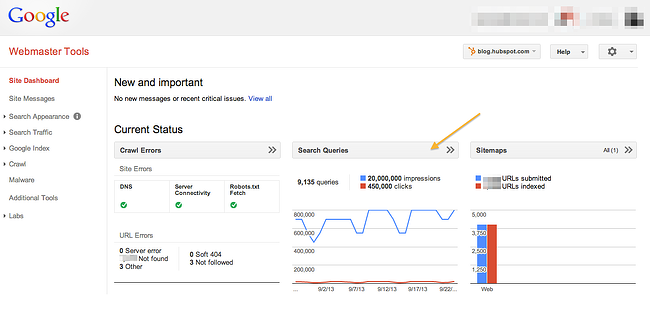
Here you’ll find a high level overview of your site’s performance and any messages Google may have for you. The section we want to dive into first is the Search Queries widget. This report can also be found under the Search Traffic section in the left hand navigation.
Digging Into Search Queries Data
The Search Queries report provides insight into Google search queries that have returned pages from your website. In other words, here you’ll get an overview of the top words and phrases that people are using to get to your website.
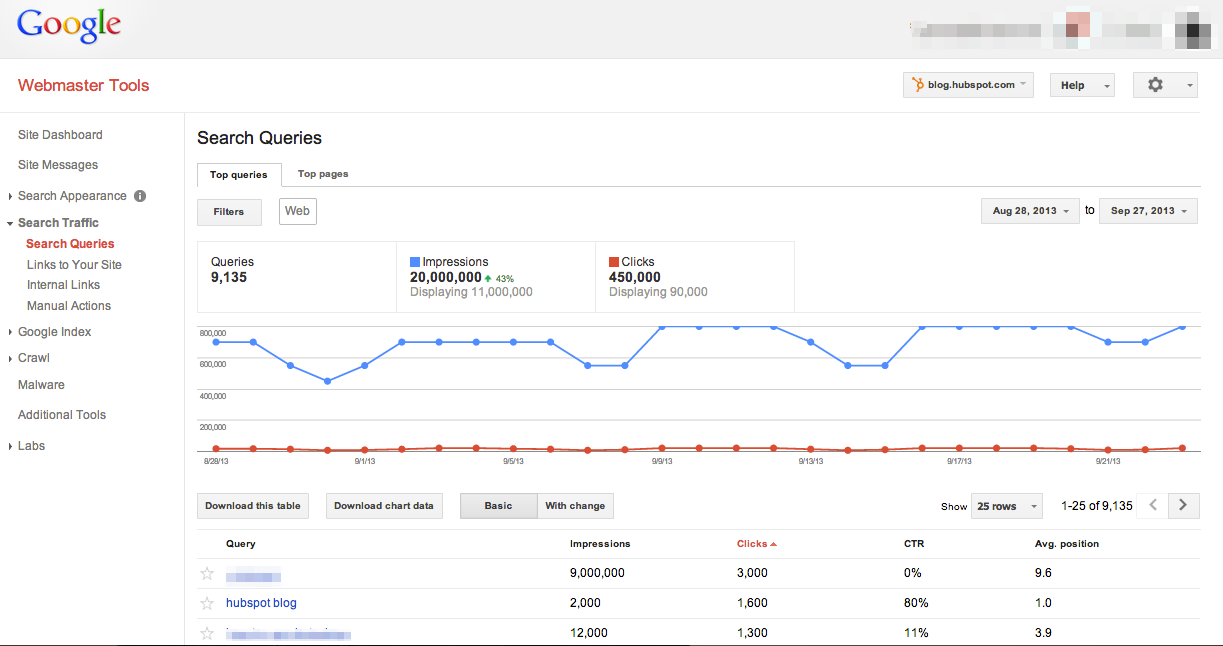
The main dashboard gives you an idea of the top traffic-driving keywords for your website and the number of impressions, clicks, the clickthrough rate, and average page position for each query for the specified period. What I love most about this data is that you’re getting not just the breakdown of the visitors who ended up on your site, but a sense of the full potential your website holds when factoring in impressions data, as well as site ranking.
A Quick Review of Terminology
Queries are the search term(s) a user typed into Google.
Impressions are the number of times a page from your website appeared on the search results page for a specific term. For example, if a user searched for ‘inbound marketing’ and a HubSpot blog post was shown as the fifth result on the first search results page, this would be counted as one impression for the search term ‘inbound marketing’. However, if this blog post ranked twelfth and only results one through ten were shown to the searcher, this would not be counted as an impression for this term unless the user went to the second page of search results.
Clicks are the number of times users selected a page from your website displayed in the search results.
Clickthrough rate (CTR) is the percentage of times a page from your website was selected from the full page of results by the user. In other words, how often searchers clicked on an impression for the query. This data provides us some insight into how well the display for this result matched the user’s query and intent.
Average position is the average top position for the query. To calculate this number, Google takes the top ranking URL from your website, disregarding all lower positions for your website for the same search query, and averages this rank over the total number of users that have performed this search.
Time to Get Our Hands Dirty
On the main search queries report page, you can sort data by any data point on the table. You also have the ability to download the data from the table or chart in Excel, which we recommend you do at regular intervals since the tool only stores 90 days of historic data. We recommend sorting the data by clicks. The default view of this report, sorted by impressions, is valuable but can distort our understanding of how our website performed for our target buyer personas. This is because, when sorted by impressions, we’re seeing the performance for both qualified and unqualified queries. When we sort by clicks, we’re focusing more closely on our target personas -- the searchers who performed the search looking for something we specifically had to offer.
When sorted by clicks, this report will show you the Google searches that bring your site the most traffic. Are these the queries you would expect to be driving traffic to your site? Do you think this traffic is qualified? Once you have your buyer personas defined, it’s good to have an understanding of how we’re performing across the board before making any changes to our strategy.
Clicking on a keyword provides a deeper dive into information about that query’s performance. In the example below, you can see which website pages showed up in search results for the query ‘what is a landing page’ and the number of impressions and clicks at the individual page level. Hovering over the grey arrow next to the page URL will show a preview of the page.
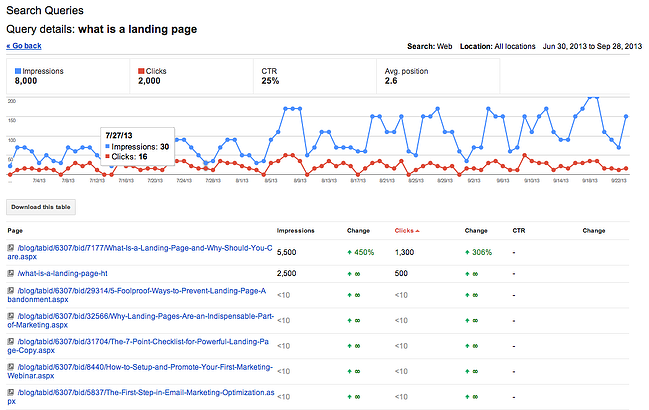
Below this table is another one that shows you the breakdown of the average page position metric, outlining the exact position in search results by user. This position will vary by searcher depending on their past search history.

Sort By Clicks, Draw Some Conclusions
As you investigate this list of pages shown for certain search queries, look for things that stand out to you. Are there pages on this list you didn’t expect to rank for this query? How many clicks does that page have? You may want to take note if the numbers are substantial. As you sift through more queries and the site pages associated with them, start building a list of the website pages you want to work on for improved user experience around specific search terms.
When reviewing the list of queries with the most clicks, you may notice some terms you would expect to see on this list missing. Time to investigate! Perform a search in an incognito browser to see how your site currently ranks for that term and what the search results display looks like. Is the display explicit and compelling? You can learn more about how to improve the title and snippets displayed in search results here.
Interpreting the CTR Story
Let’s go back to the main search queries report and sort our list by click-through rate or CTR. How should you interpret this number? Well, broadly speaking, queries with a high CTR likely have associated website pages with a compelling search results display. When you see low CTR numbers for queries you believe are relevant to your buyer personas, you’ll want to look into improving the search results display for related website pages.
As you did with clicks, dig through this list to see if any queries are not performing as expected. Then assess whether there is an opportunity to improve the page title or snippets displayed on the search results page for this query.
BONUS: A Few Other Reports to Keep Tabs On
While you’re still poking around your Google Webmaster Tools data, be sure to check these few other reports every once in a while. While not as robust as the Search Queries reports, you never know what sort of trends you might pick up on!
Check Your Links: Links to Your Site and Internal Links
Both of these reports are found under the Search Traffic section in the left hand navigation menu. The Links to Your Site report shows you the total number of links from other websites pointing to a page on your website, as well as a listing of who links to you the most, which website pages are the most linked to, and which anchor text is being used with these links (labeled ‘how your data is linked’).
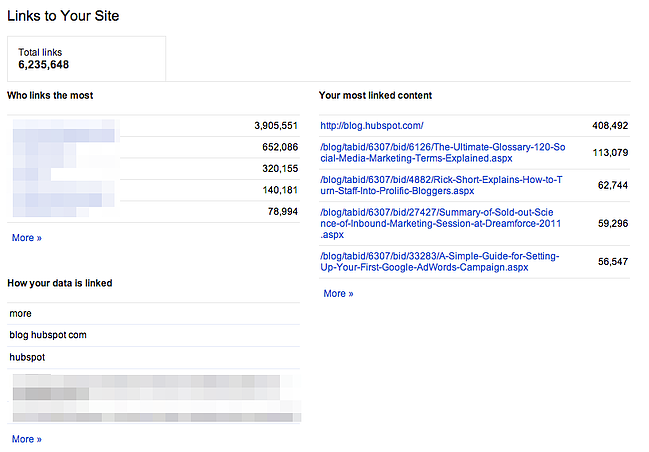
The Internal Links report shows the webpages that are linked to most often within your website. When done properly, internal linking can help search engines better assess and index your website which usually helps increase your search rankings. Reviewing this report may uncover opportunities to include certain internal pages in your internal linking strategy for increased traffic to specific pages and improved user experience.
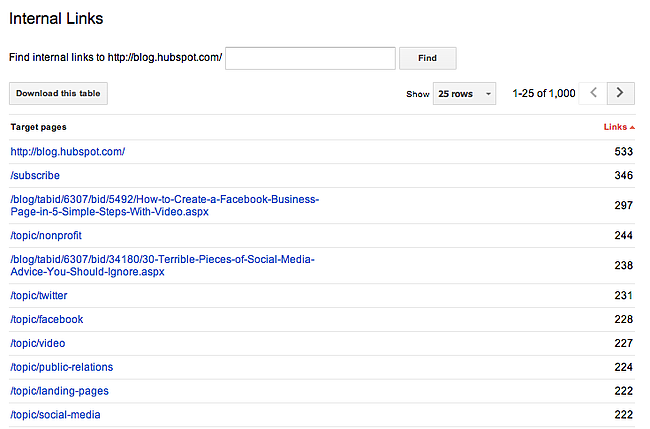
Whether internal or from another website, each link to a page on your site is a vote to rank that page higher for a specific search query. Keep this in mind when you export both of these reports to check for things like low quality websites linking to yours (get rid of these immediately), anchor text that’s too long (might be hurting you), and missed opportunities for more diversified internal linking (be strategic and reasonable here).
Content Keywords: A Quick Pulse Check
The Content Keywords tab, found under the Google Index section in the left hand navigation, lists the most common keywords Google found when crawling your website. By extension, these are the keyword queries that most often display search results from your website. Keep an eye out for unexpected keywords on this list as this will warrant further investigation and, very likely, corrective action.
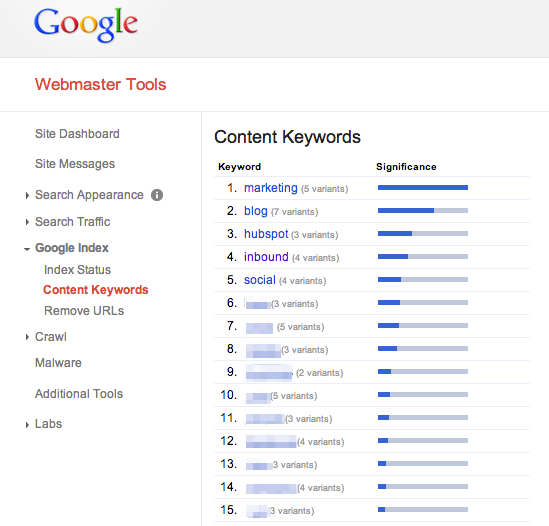
Entering a Brave New World
We hope you’re feeling a little better about the amount of keyword data that is still available to you, dear marketer. While the data will no longer tie a new lead to the initial search query that brought them to your site, there is still a wealth of information to help you understand what’s driving traffic to your website. This isn’t the first time Google has changed the SEO game and it won’t be the last. We hope this latest shift will move the preoccupation away from ‘over optimizing’ and toward creating great, valuable content for your target audiences.
After the initial punch to the gut after Google’s announcement last week, how are you feeling about the future of search optimization? What else are you doing to continue to improve your organic search strategy?
Image credit: Mafue







